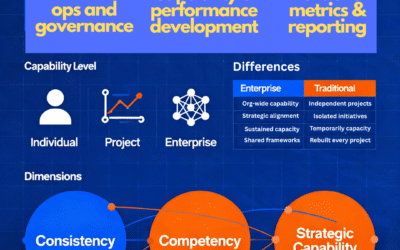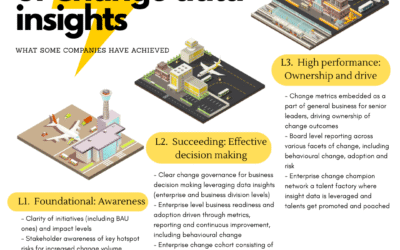Understanding the real distinction between traditional, project-focused change management and the practice of enterprise change management (ECM) opens the door to a structured approach to genuine organisational agility and resilience. While project-based approaches often provide short-term benefits, ECM elevates change to an ongoing strategic capability, ensuring the entire organisation moves in concert rather than as a collection of isolated initiatives.
Rethinking the project lens
Traditionally, change management has surfaced in response to specific projects or change initiatives such as rolling out new technology platforms, redesigning new processes, digital transformation or introducing new products. These efforts share familiar hallmarks:
Project teams focus their energy on preparing the change process for affected employees, ensuring communications are clear, training is tailored, and stakeholder concerns are addressed swiftly. Metrics such as training completion rates or engagement scores offer a sense of progress, and feedback loops close as soon as “go-live” is achieved.
- Project-centric change targets only those directly impacted by the initiative.
- Output-based indicators (e.g., attendance, survey participation) dominate measurement.
- Coordination and collaboration between projects may be limited or absent.
Yet, this approach can quickly run into problems as the scale and frequency of the pace of change grows. And let’s face it, which sizeable organisation isn’t going through multiple changes at the same time? What appears to be a tightly managed process locally can, at an organisational level, lead to fragmentation, duplicated effort, and staff exhaustion – sometimes described as “change fatigue”. Diverse teams may be asked to adapt to multiple new systems, processes or behaviours in rapid succession, often with little integration or prioritisation.
Making sense of change saturation
Change fatigue is not a product of resistance to ‘doing things differently’ – it’s a predictable response when staff face overlapping initiatives with inadequate support or context. Portfolio-level visibility is rare in project-centric models, so team members may juggle competing demands with limited clarity on which changes matter most.
- People become disengaged when the rationale for change is unclear or inconsistent.
- Fragmented delivery means lessons learnt in one project aren’t transferred to others.
- Resource conflicts emerge, exacerbating the pace and stress of simultaneous transitions.
Such issues underscore why organisations are searching for a more holistic way to approach change. Rather than reactively managing each initiative, ECM creates a deliberate structure for balancing effort, building capability, and driving lasting value in support of organisational strategy.
Enterprise change management: Strategic integration
ECM is not a “set and forget” solution, nor a suite of templates for project managers to file away. It’s a disciplined, repeatable practice, and an approach that blends governance, data, collaboration and technology so that change becomes woven into daily operations. The core aim is for organisational change to transform from a series of disruptions to a united strategic capability aligned with strategic objectives and goals at various levels of the organisation.
Anchoring change in strategy and purpose
ECM starts with a clear connection to strategy. Initiatives are not pursued simply because they fit a project schedule – they are selected, sequenced and resourced to deliver against longer-term organisational goals and values. This strategic alignment requires regular, portfolio-wide reviews and a strong sense of interdependencies.
- Change activity is mapped against broader business priorities for successful change management.
- Leadership and employee engagement is visible and continuous throughout cycles of change.
- Decisions are made with an understanding of cumulative change impact on staff and operations.
Governance and portfolio management
One of the defining features of ECM is the elevation of governance from discrete project steering groups to enterprise-wide oversight. This means all change activity – from small tweaks to major transformations – is managed within a portfolio framework. Coordinated governance offers leaders:
- Real-time visibility of all initiatives, reducing risk of overlapping or conflicting changes;
- The ability to sequence work to avoid bottlenecks or overload;
- Standard tools for collecting outcomes, learning, and scaling success.
This portfolio approach doesn’t stifle innovation or agility – it enables them. With the big (and ‘medium’) picture in hand, leadership can make timely adjustments, redirect resources where needed, and capitalise on synergies between concurrent change efforts.
Consistent methodology and language
To embed ECM, organisations need a consistent approach to how change is defined, planned, and delivered. This includes shared terminology, frameworks, capability building and tools. A common language ensures that teams across functions understand what’s expected and how to measure success.
- Shared frameworks reduce confusion and speed up onboarding new projects.
- Common metrics allow lessons learnt from one area to influence others.
- Continuous capability development ensures capability is refreshed as the organisation evolves (and capability does not just refer to training).
Cultivating organisational capability
ECM demands proactive investment in building change expertise at all levels, including the enterprise level. Unlike traditional approaches centred in specialist teams, ECM diffuses capability throughout the organisation. Everyone – from the executive team to frontline employee change champions – can access the knowledge, resources, and support necessary to champion change in their own environment.
The benefit of this diffusion is that change management doesn’t become a bottleneck or a specialist bottling plant; rather, it becomes part of the organisational DNA, supporting sustainable transitions even as pressure for change intensifies.
- Capability-building programs help embed change management skills into routine business operations.
- Peer communities foster exchange of techniques, stories and practical tools.
- Capability-building programs help embed change into routine business operations.
Integrating change with core functions
Real value arises when change management links arms with other core business functions – risk, finance, HR, operations, technology:
- Risk management: Proactive identification and management of people-related and operational risks ensure less disruption and faster remediation.
- Human resources: Structured alignment of talent, training and role transitions supports staff through periods of uncertainty.
- Finance: Budgets reflect strategic priorities and benefit targets, allowing responsive reallocation as circumstances shift.
- Operations: Rollouts are coordinated with and catered to day-to-day workflow, minimising friction and confusion.
This interconnected approach elevates change from a project concern to a constant enabler, strengthening business readiness and agility.
Data, measurement and digital enablement
ECM takes measurement seriously, moving beyond output metrics to focus on outcomes and behaviour. Reporting and analytics track adoption rates, operational impact, readiness levels, and risk hotspots across all initiatives in progress.
- Dashboards provide visibility for boards, executive teams and change leaders.
- Analytics highlight trends over time, support decision-making, and provide evidence for resource allocation, including data on impact, capacity, readiness and adoption
- Stakeholder feedback is collected continuously and drives refinement of practices.
Digital platforms make this easier – centralising data, automating routine assessments, and allowing fast recognition of leading and lagging indicators in change efforts. However, technology is an enabler not a replacement for skilled analysis and strategic judgement.
Continuous improvement and learning loops
ECM embeds cycles of review, adjustment and learning. Change accelerates, but so too does the speed of feedback, reflection, and correction. Leaders and teams benefit from:
- Structured periodic reviews such as portfolio level PI planning (program increment planning);
- Real-time lessons learned loops;
- Identification and scaling of success stories;
- Open channels for feedback and honest discussion.
These activities foster resilience, build trust, and demystify the process of change, turning every initiative – successful or otherwise – into an opportunity for deeper organisational learning.
Overcoming obstacles in enterprise change management
Establishing ECM is a long-term commitment and not without its challenges. Common obstacles include:
- Leadership inertia or lack of sustained sponsorship;
- Underinvestment in resources and capability growth;
- Cultural resistance – where staff view working with change data as a burden rather than an opportunity;
- Conflicting priorities between business units;
- Difficulty standardising reporting or aligning diverse teams.
Overcoming these barriers requires persistent engagement, investment in technology and skills, and a strong focus on communication. Leadership needs to be visible, responsive, and ready to recalibrate as conditions change.
Implementing enterprise change management: A practical roadmap
Organisations seeking to build ECM need a clear game plan. Here’s a practical roadmap synthesised from best practice:
- Vision and Alignment
Begin with a shared understanding of why ECM matters and the results it is supposed to deliver. Shape the vision in conversation across the business, not from the top down. - Assessment of Current State Map change activity in flight, assess capability gaps, and audit readiness. Involve a range of stakeholders in the diagnosis phase to surface risks and opportunities, including readiness assessments where applicable.
- Strategic Planning and Design
Create a blueprint for integrated governance, methodology, and reporting lines. Define responsibilities, success measures and timing with input from relevant business units. - Capability-Building Investment
Establish ongoing programs for training, coaching, and skill development. Make capability-building an expected part of career pathways and leadership routines. - Technology Selection and Integration
Choose digital tools that fit scale, and goals. Integrate with other business systems where it makes sense for seamless reporting. - Delivery and Implementation
Roll out ECM frameworks in parallel with major projects and business-as-usual activities. Regularly review progress, and support teams with tailored resources. - Evaluation, Review and Improvement
Set up mechanisms for real-time feedback and course correction. Celebrate success, learn from setbacks, and continually update strategies as the business evolves.
Measuring value: Enterprise change management metrics
Demonstrating the value of ECM requires robust evidence that change capability translates into real organisational outcomes. Key measures include key performance indicators related to adoption rates: How quickly and thoroughly staff take up new behaviours, systems or processes.
- Adoption rates: How quickly and thoroughly staff take up new behaviours, systems or processes.
- Readiness indices: Staff sense of preparedness and confidence ahead of change launches.
- Business impact: Direct and indirect effects of change on performance, service delivery, quality, and customer satisfaction.
- Resource allocation and utilisation: Efficiency in people, budget, and technology deployment over time.
- Lessons learnt and continuous improvement: Degree of learning captured and applied to future projects.
Using a dashboard approach, organisations can compare progress between regions or functions, surface best practices, and allocate resources based on what works.
Enterprise change in action
ECM comes to life best through real examples. Consider an organisation embarking on major tech transformation. Early stages are plagued with confusion over responsibilities, inconsistent reporting, and pockets of resistance. By shifting to an ECM approach, the organisation sets up a central governance board, standardises its methodology, introduces regular engagement forums, and builds ongoing feedback loops.
- The pace of adoption increases as staff gain clarity.
- Risks are flagged earlier, allowing for timely intervention.
- Costs are controlled through better prioritisation.
- Change becomes less disruptive, more predictable, and ultimately more valuable.
In another scenario, a business grapples with multi-site process rollouts. ECM allows for custom pacing, local adaptation with centralised oversight, and regular calibration of resource needs. Staff feel more engaged and less overwhelmed, while leadership gains better transparency over outcomes.
Frequently Asked Questions
Why is ECM worth the investment?
ECM isn’t a luxury – it’s an organising principle for sustainable performance. It helps prevent costly failures and delays, reduces risk, and builds shared capability that fuels growth in an increasingly volatile world.
How does ECM drive transformation success?
By connecting change activity directly to broader strategy, creating clear frameworks and governance, and embedding skills at every level, ECM supports smooth, coordinated transitions – turning vision into reality with measurable benefit.
What analytical tools and technology support ECM?
Dashboards, portfolio level charts, and centralised analytics platforms provide transparency, drive accountability, and highlight the most impactful interventions. These tools work best when paired with regular dialogue and active review. Starting with simple excel sheets may make sense, but in the longer term have significant limitations.
How do organisations diffuse change leadership beyond core teams?
Training programs, peer communities, and open communication mean staff across every function can act as change advocates, spreading best practice without relying on a small group of specialists.
Final reflections
Enterprise change management represents a profound shift away from treating change as a series of one-off events towards establishing enduring, organization-wide capabilities in organizational change management. Through strategic alignment, integrated governance, continuous development, and robust measurement, ECM helps businesses thrive amid complexity and uncertainty, significantly improving the change implementation process.
The journey toward ECM takes sustained commitment, but the benefits – a culture that welcomes new ideas, adapts faster, and builds lasting value – are worth the effort. For those determined to succeed, ECM stands not just as a methodology, but the bedrock of a truly adaptive organisation.
What this also means is that the change and transformation team or practice increases its influence and contribution to the business goals in a direct way. Senior leaders and key stakeholders will see very clearly the value and contribution of the change management team and how it drives forward the business agenda. Gone are the days where change practice is seen as a nice-to-have with little contribution to business objectives.





